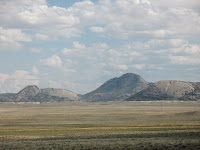



One paragraph in the book, Prospecting Wyoming, says that, "Agates were at one time hauled by wagon to Rawlins, and even shipped to Germany". So of course we had to go there even though it said that today surface pickings were non existent and that one had to dig to find them.
It was a short Wyoming drive, 66 miles, to Agate flats. The last nine miles were on a gravel road that wasn't too bad by Wyoming Standards. The book had also mentioned that during World War Two planes had practiced machine gunning the ridge at the Flats as it resembled, kind of a battle ship.
Arriving we were immediately overwhelmed by the size of the flat, where would we start? So we drove and stopped several times, checking out the ditch, which had recently been graded. We didn't find anything that even closely resembled the picture of the agates that we had.
Heading north we hunted near a ridge, formed by a granite outcrop, and even though we found some other samples, Renita found a beautiful black and pink gneiss, we didn't find any agates. So we turned the truck around and headed back south till we got to the middle of the flats.
Parking the truck off the road we started to hunt for the elusive agates, surface picking but not digging and by golly I found one! Showing it to Renita she soon found one and I found two more. We were both excited as we broke for lunch, feeling good that we had actually found some and deciding that we would stay in the same area and not dig but continue to surface pick.
Shortly after we resumed looking I saw what looked like a garden hose nozzle lying half buried in the soil. Picking it up I saw that it was a brass 20 mm cannon shell from World War Two! A little later I found a metal piece from an ammunition belt.
The hunting for the agates was less lucky as we only found two more agates the rest of the day.
We did stop and talk with some other folks who had found some agates near the water tanks and we looked there but only found some of the less desired brown agates mentioned by the book. We did find what we thought was called snowflake jade, which is jade with quartz crystals. Its not a popular rock as the quartz undercuts and doesn't polish. We also found some amazonite which is locally refereed to as green granite,(Its actually a green feldspar).
Leaving we drove about a mile and soon after we crossed the Sweetwater River, I barely missed what looked like a snake crossing the road. A little further was another and this one was definetly a rattlesnake!
Grabbing the camera I got as close as I dared, Renita thought I was a little to close, and I could actually see the snake measuring the distance as it coiled and rattled. It dared me to come closer, but all I wanted was the picture. I like it when rattlesnakes rattle and prefer to leave them alone. We drove next to the snake and Renita snapped some pictures and listened to it rattle.
It was the first rattlesnake she had ever seen in the wild and only the sixth one for me, although I am always watching for them. It kind of tells you how overblown peoples fears are of rattlesnakes, and I do admit that at one time snakes were one of my worst fears(Unless of course you are near a den).
We drove away leaving the snake to continue it journey, hoping it would crawl into the grass before someone less kind to snakes would see it and dispatch it for its rattles. he rest of the drive home was windy and the truck swayed as the sideways wind tried to push the truck with the canoe.
We talked of the days finds and our impression of Agates Flats, and we both agreed that we would like to return here again, and maybe even do some digging. We passed Jeffery City and Sweetwater Station and talked about the Oregon Trail, which paralleled the river. A good day, prospecting is so more enjoyable than working! Clear skies.
Be sure to click on the rattlesnake picture to see the tongue!

1 comment:
We will have to compare rattlesnake encounters some time. I have had the dubious pleasure of meeting up with about 6 of them when I was working as a botanist for the Stanislaus Natl Forest. And they don't all rattle. Sharon
Post a Comment